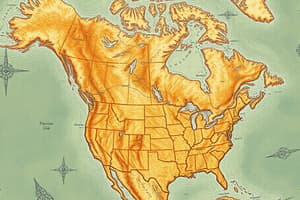Podcast
Questions and Answers
Flashcards are hidden until you start studying
Study Notes
Geography of North America
-
Location:
- North America is located in the Northern Hemisphere and mostly in the Western Hemisphere.
- Bordered by the Arctic Ocean (north), Atlantic Ocean (east), Pacific Ocean (west), and the Caribbean Sea (southeast).
-
Land Area:
- Approximately 24.7 million square kilometers, making it the third-largest continent.
-
Major Regions:
- Canada: Northernmost country, featuring vast forests, tundra, and mountain ranges (Rocky Mountains).
- United States: Diverse landscapes including plains, mountains (Appalachians, Sierra Nevada), deserts, and coastal regions.
- Mexico: Known for its varied terrain including mountains, arid deserts, and tropical beaches.
-
Topography:
- Mountain Ranges: Rocky Mountains (west), Appalachian Mountains (east).
- Plains: Great Plains in the central region, fertile and important for agriculture.
- Lakes and Rivers: Home to the Great Lakes (Superior, Michigan, Huron, Erie, Ontario) and major rivers such as the Mississippi, Missouri, and Colorado.
-
Climate Zones:
- Arctic: Northern Canada, characterized by cold temperatures and tundra.
- Temperate: Central and eastern U.S. and southern Canada, featuring four distinct seasons.
- Desert: Southwestern U.S. and northern Mexico, with hot, dry conditions.
- Tropical: Southeastern Mexico and parts of Central America, warm with high humidity.
-
Natural Resources:
- Abundant resources including oil, natural gas, minerals (gold, silver), and timber.
- Fertile agricultural land, particularly in the Midwest U.S. and Canadian Prairies.
-
Biodiversity:
- Varied ecosystems ranging from tundra to rainforests.
- Home to diverse wildlife, including bears, bison, deer, and numerous bird species.
-
Human Geography:
- Population centers include major cities like New York, Los Angeles, Toronto, and Mexico City.
- Cultural diversity influenced by indigenous peoples, colonization, and immigration patterns.
Location
- Situated mainly in the Northern and Western Hemispheres.
- Bordered by the Arctic Ocean (north), Atlantic Ocean (east), Pacific Ocean (west), and Caribbean Sea (southeast).
Land Area
- Covers approximately 24.7 million square kilometers, ranking as the third-largest continent globally.
Major Regions
- Canada: Northernmost country featuring vast forests, tundra, and the Rocky Mountains.
- United States: Home to diverse landscapes, including the Great Plains, Appalachian Mountains (east), Sierra Nevada (west), deserts, and coastal areas.
- Mexico: Notable for its varied terrain including mountains, arid deserts, and tropical beaches.
Topography
- Mountain Ranges: Includes the Rocky Mountains in the west and the Appalachian Mountains in the east.
- Plains: Dominated by the Great Plains, crucial for agriculture due to its fertile land.
- Lakes and Rivers: Hosts the Great Lakes (Superior, Michigan, Huron, Erie, Ontario) and significant rivers such as the Mississippi, Missouri, and Colorado.
Climate Zones
- Arctic: Found in northern Canada; characterized by extreme cold and tundra conditions.
- Temperate: Central and eastern U.S. and southern Canada; experiences four distinct seasons.
- Desert: Southwestern U.S. and northern Mexico; associated with hot, dry climates.
- Tropical: Southeastern Mexico and parts of Central America; warm and humid conditions prevail.
Natural Resources
- Rich in resources, including oil, natural gas, minerals (gold, silver), and timber.
- Fertile agricultural land particularly concentrated in the Midwest U.S. and Canadian Prairies.
Biodiversity
- Features a wide range of ecosystems from tundra to rainforests.
- Supports diverse wildlife, including bears, bison, deer, and various bird species.
Human Geography
- Major urban centers include New York, Los Angeles, Toronto, and Mexico City.
- Cultural diversity shaped by indigenous populations, colonization history, and immigration trends.
Location
- North America is primarily in the Northern and Western Hemispheres.
- Bordered by the Arctic Ocean (north), Atlantic Ocean (east), Pacific Ocean (west), and Caribbean Sea (southeast).
Countries
- Comprises 23 countries, with Canada, the United States, and Mexico as the largest.
- Other significant countries include Guatemala, Cuba, Haiti, and the Dominican Republic.
Physical Features
- Mountain Ranges:
- Rocky Mountains extend from Canada to New Mexico.
- Appalachian Mountains stretch from eastern Canada to Alabama.
- Plains:
- Great Plains are centrally located, known for their agricultural output.
- Deserts:
- Sonoran Desert is situated in the southwestern U.S. and northwestern Mexico.
- Mojave Desert is found in California, Nevada, Utah, and Arizona.
- Water Bodies:
- Major rivers include the Mississippi, Missouri, Colorado, and St. Lawrence.
- The Great Lakes consists of Superior, Michigan, Huron, Erie, and Ontario.
Climate
- Experiences diverse climate zones, from Arctic in the north to tropical in the south.
- Weather patterns influenced by geographic features such as mountains and water bodies.
Natural Resources
- Rich in natural resources like oil, natural gas, coal, minerals, and forests.
- Agriculture thrives, producing crops such as corn, wheat, soybeans, and cotton.
Ecosystems
- Hosts various ecosystems: tundra in the north, temperate forests, grasslands, and deserts.
- Supports diverse wildlife, including bears, bison, and numerous bird species.
Urban Areas
- Major cities include New York City, Los Angeles, Toronto, Mexico City, and Chicago.
- Urbanization has significantly altered the geography and environment of the continent.
Islands and Territories
- Notable islands are Greenland (largest), the Bahamas, and various Caribbean Islands.
- Territories include Puerto Rico, Bermuda, and several offshore islands.
Geological Features
- Prominent geological formations include the Grand Canyon, Appalachian Mountains, and the Mississippi River Delta.
- Features a variety of geological formations, such as sedimentary, igneous, and metamorphic rocks.
Location
- North America is situated in the Northern Hemisphere, bordered by the Arctic Ocean (north), Atlantic Ocean (east), Pacific Ocean (west), and Caribbean Sea (southeast).
Regions
- Canada: The northernmost country, known for extensive wilderness and the Rocky Mountains.
- United States: Features a variety of landscapes, including mountains, plains, forests, and deserts.
- Mexico: Positioned to the south, characterized by mountains, plateaus, and diverse coastal regions.
Major Physical Features
- Mountain Ranges:
- Rocky Mountains extend from Canada to New Mexico, offering mountainous terrain and ecosystems.
- Appalachian Mountains run along the eastern part of the United States, known for their age and biodiversity.
- Plains:
- Great Plains, located in the central U.S. and Canada, primarily serve agricultural purposes due to their flat terrain.
- Rivers:
- Mississippi River, one of North America's longest, flows from Minnesota to the Gulf of Mexico.
- Missouri River is a key tributary of the Mississippi, contributing significantly to its flow.
- St. Lawrence River connects the Great Lakes to the Atlantic Ocean, playing a vital role in trade and navigation.
Climate
- Climate varies extensively, ranging from polar conditions in the Arctic north to tropical climates in southern Mexico.
- Four primary climate zones:
- Arctic: Characterized by cold, harsh winters and short summers.
- Continental: Features hot summers and cold winters, common in central U.S. and Canada.
- Mediterranean: Mild, wet winters and hot, dry summers, particularly in coastal California.
- Tropical: Consistently warm temperatures and significant rainfall, mainly in southeast Mexico.
Natural Resources
- North America possesses abundant natural resources, including forests, minerals, and fossil fuels.
- Major agricultural outputs consist of grains, fruits, and livestock, bolstering the economy.
Islands and Archipelagos
- Newfoundland is a significant island located in Canada, well-known for its rugged coastlines.
- Caribbean Islands represent a diverse collection of islands southeast of the U.S. and Mexico, rich in ecosystems and cultural heritage.
Biodiversity
- The continent features various ecosystems, including tundra, temperate forests, grasslands, deserts, and marine environments.
- Numerous national parks and protected areas conserve wildlife and habitats, supporting the continent's biodiversity.
Population Distribution
- Population is heavily concentrated in urban coastal areas, particularly in the United States and Canada.
- Sparse populations exist in northern regions and rugged terrain, resulting in lower urbanization rates in these areas.
Geography of North America
- Location:
- Northern Hemisphere with a significant portion in the Western Hemisphere.
- Bordered by Arctic Ocean (north), Atlantic Ocean (east), Pacific Ocean (west), and Caribbean Sea (southeast).
Regional Overview
- Canada:
- Second-largest country globally, renowned for extensive wilderness; comprises multiple provinces and territories.
- United States:
- Features a rich variety of landscapes; organized into 50 states with diverse climate regions and geographical characteristics.
- Mexico:
- Situated south of the U.S.; noted for mountain ranges, plateaus, and coastal plains.
Major Landforms
- Rocky Mountains:
- Major mountain range extending from Canada through the U.S. to Mexico; known for its dramatic elevations.
- Appalachian Mountains:
- Older mountain range located in eastern U.S.; stretches from Canada to Alabama.
- Great Plains:
- Expansive grassland area in central North America; critical for agricultural practices.
- Mississippi River:
- One of the longest rivers in the U.S.; vital for trade and transportation networks.
- Great Lakes:
- Comprises five significant interconnected lakes—Superior, Michigan, Huron, Erie, and Ontario—positioned between Canada and the U.S.
Climate Zones
- Tundra:
- Predominant in northern Canada; characterized by frigid temperatures and permafrost conditions.
- Temperate:
- Main climate in the U.S. and southern Canada; features four distinct seasons with variable precipitation patterns.
- Desert:
- Exist in southwestern U.S. and northern Mexico; identifiable by low rainfall and extreme temperature variations.
- Tropical:
- Found in southern Mexico and parts of Central America; marked by warm temperatures and high humidity levels.
Natural Resources
- Wealth of resources such as minerals, forests, and freshwater.
- Significant oil reserves located in Canada and the U.S.; the Great Plains are known for valuable agricultural output.
Biodiversity
- Rich ecosystems, including tundras, forests, deserts, and wetlands.
- Home to a wide range of wildlife including bears, moose, and various bird species.
Population Distribution
- High population density along the U.S. East Coast and West Coast, as well as major Canadian cities like Toronto and Vancouver.
- Sparse populations found in northern Canada and the interior regions of Mexico.
Studying That Suits You
Use AI to generate personalized quizzes and flashcards to suit your learning preferences.





